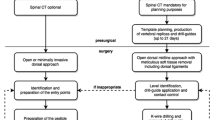Abstract
Introduction
The method of free-hand pedicle screw placement is generally safe although it carries potential risks. For this reason, several highly accurate computer-assisted systems were developed and are currently on the market. However, these devices have certain disadvantages. We have developed a method of pedicle screw placement in the lumbar and sacral region using a multi-level drill guide template, created with the rapid prototyping technology and have validated it in a clinical study. The aim of the study was to manufacture and evaluate the accuracy of a multi-level drill guide template for lumbar and first sacral pedicle screw placement and to compare it with the free-hand technique under fluoroscopy supervision.
Materials and methods
In 2011 and 2012, a randomized clinical trial was performed on 20 patients. 54 screws were implanted in the trial group using templates and 54 in the control group using the fluoroscopy-supervised free-hand technique. Furthermore, applicability for the first sacral level was tested. Preoperative CT-scans were taken and templates were designed using the selective laser sintering method. Postoperative evaluation and statistical analysis of pedicle violation, displacement, screw length and deviation were performed for both groups.
Results
The incidence of cortex perforation was significantly reduced in the template group; likewise, the deviation and displacement level of screws in the sagittal plane. In both groups there was no significantly important difference in deviation and displacement level in the transversal plane as not in pedicle screw length. The results for the first sacral level resembled the main investigated group.
Conclusions
The method significantly lowers the incidence of cortex perforation and is therefore potentially applicable in clinical practice, especially in some selected cases. The applied method, however, carries a potential for errors during manufacturing and practical usage and therefore still requires further improvements.




Similar content being viewed by others
References
Mattei TA, Meneses MS, Milano JB, Ramina R (2009) “Free-hand” technique for thoracolumbar pedicle screw instrumentation: critical appraisal of current “state-of-art”. Neurol India 57(6):715–721
Zeiller SC, Lee J, Lim M, Vaccaro AR (2005) Posterior thoracic segmental pedicle screw instrumentation: evolving methods of safe and effective placement. Neurol India 53:458–465
Berlemann U, Langlotz F, Langlotz U, Nolte LP (1997) Computer-assisted orthopedic surgery. From pedicle screw insertion to further applications. Orthopade 26:463–469
Richards PJ, Kurta IC, Jasani V, Jones CH, Rahmatalla A, Mackenzie G et al (2007) Assessment of CAOS as a training model in spinal surgery: a randomised study. Eur Spine J 16:239–244
Youkilis AS, Quint DJ, McGillicuddy JE, Papadoupoulos SM (2001) Stereotactic navigation for placement of pedicle screws in the thoracic spine. Neurosurgery 48:771–778
Hughes SP, Anderson FM (1999) Infection in the operating room. J Bone Jt Surg Br 81(5):754–755
Lim MR, Girardi FP, Yoon SC et al (2005) Accuracy of computerized frameless stereotactic image-guided pedicle screw placement into previously fused lumbar spines. Spine 30(15):1793–1798
Sagi HC, Manos R, Benz R et al (2003) Electromagnetic field-based image-guided spine surgery, part 1: results of a cadaveric study evaluating lumbar pedicle screw placement. Spine 28(17):2013–2018
Birnbaum K, Schkommodau E, Decker N, Prescher A, Klapper U, Radermacher K (2001) Computer-assisted orthopaedic surgery with individual templates and comparison to conventional operation method. Spine 26(4):365–369
Radermacher K, Portheine F, Anton M, Zimolong A, Kaspers G, Rau G, Staudte HW (1998) Computer assisted orthopaedic surgery with image based individual templates. Clin Orthop Relat Res 354:28–38
Van Brussel K, Vander SJ, van Audekercke R, Swaelens B, Vanden Berghe L, Fabry G (1998) A medical image based template for pedicle screw insertion. Comput Methods Biomech Biomed Eng 2:347–354
Berry E, Cuppone M, Porada S, Millner PA, Rao A, Chiverton N, Seedhom BB (2005) Personalised image-based templates for intra-operative guidance. Proc Inst Mech Eng H 219(2):111–118
Goffin J, Van Brussel K, Martens K, Vander Sloten J, Van Audekercke R, Smet MH (2001) Three-dimensional computed tomography-based, personalized drill guide for posterior cervical stabilization at C1–C2. Spine 26(12):1343–1347
Owen BD, Christensen GE, Reinhardt JM, Ryken TC (2007) Rapid prototype patient-specific drill template for cervical pedicle screw placement. Comput Aided Surg 12(5):303–308
Lu S, Xu YQ, Zhang YZ, Li YB, Xie L, Shi JH et al (2009) A novel computer-assisted drill guide template for lumbar pedicle screw placement: a cadaveric and clinical study. Int J Med Robot 5(2):184–191
Ma T, Xu YQ, Cheng YB, Jiang MY, Xu XM, Xie L, Lu S (2012) A novel computer-assisted drill guide template for thoracic pedicle screw placement: a cadaveric study. Arch Orthop Trauma Surg 132(1):65–72
Lu S, Zhang YZ, Wang Z, Shi JH, Chen YB, Xu XM, Xu YQ (2012) Accuracy and efficacy of thoracic pedicle screws in scoliosis with patient-specific drill template. Med Biol Eng Comput 50(7):751–758
Drstvensek I, Ihan Hren N, Strojnik T, Brajlih T, Valentan B, Pogacar V, Zupancic Hartner T (2008) Applications of rapid prototyping in cranio-maxilofacial surgery procedures. Int J Biol Biomed Eng 1:29–38
Brasiliense LB, Theodore N, Lazaro BC, Sayed ZA, Deniz FE, Sonntag VK, Crawford NR (2010) Quantitative analysis of misplaced pedicle screws in the thoracic spine: how much pullout strength is lost? J Neurosurg Spine 12(5):503–508
Acknowledgments
Each author certifies that he has no commercial or any other associations that might pose a conflict of interest in connection with the submitted article. The authors would like to thank the Department of Radiology in UMC Maribor, Slovenia, for assistance with the CT data scanning and collection.
Author information
Authors and Affiliations
Corresponding author
Rights and permissions
About this article
Cite this article
Merc, M., Drstvensek, I., Vogrin, M. et al. A multi-level rapid prototyping drill guide template reduces the perforation risk of pedicle screw placement in the lumbar and sacral spine. Arch Orthop Trauma Surg 133, 893–899 (2013). https://doi.org/10.1007/s00402-013-1755-0
Received:
Published:
Issue Date:
DOI: https://doi.org/10.1007/s00402-013-1755-0




